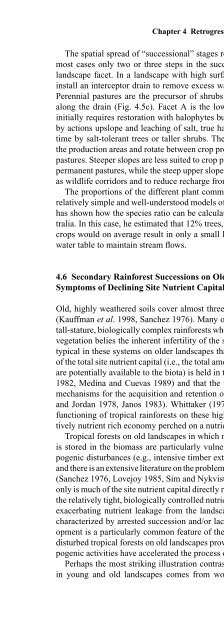Linking Restoration and Ecological Succession (Springer ... - Inecol
Linking Restoration and Ecological Succession (Springer ... - Inecol
Linking Restoration and Ecological Succession (Springer ... - Inecol
Create successful ePaper yourself
Turn your PDF publications into a flip-book with our unique Google optimized e-Paper software.
Chapter 4 Retrogressive <strong>Succession</strong> <strong>and</strong> <strong>Restoration</strong> on Old L<strong>and</strong>scapes 81<br />
The spatial spread of “successional” stages replaces time with space <strong>and</strong> in<br />
most cases only two or three steps in the succession are needed in any one<br />
l<strong>and</strong>scape facet. In a l<strong>and</strong>scape with high surface run-off, the first step is to<br />
install an interceptor drain to remove excess water <strong>and</strong> store it in local dams.<br />
Perennial pastures are the precursor of shrubs <strong>and</strong> trees that are established<br />
along the drain (Fig. 4.5c). Facet A is the lowest part of the l<strong>and</strong>scape <strong>and</strong><br />
initially requires restoration with halophytes but as the water table is lowered<br />
by actions upslope <strong>and</strong> leaching of salt, true halophytes can be replaced over<br />
time by salt-tolerant trees or taller shrubs. The lower slopes (B) <strong>and</strong> (C) are<br />
the production areas <strong>and</strong> rotate between crop production <strong>and</strong> perennial grazing<br />
pastures. Steeper slopes are less suited to crop production <strong>and</strong> are placed under<br />
permanent pastures, while the steep upper slopes <strong>and</strong> crests are planted to trees<br />
as wildlife corridors <strong>and</strong> to reduce recharge from these areas.<br />
The proportions of the different plant communities can be estimated using<br />
relatively simple <strong>and</strong> well-understood models of plant water use. Dunin (2002)<br />
has shown how the species ratio can be calculated for a farm in Western Australia.<br />
In this case, he estimated that 12% trees, 30% lucerne, <strong>and</strong> 58% annual<br />
crops would on average result in only a small leakage of water to the ground<br />
water table to maintain stream flows.<br />
4.6 Secondary Rainforest <strong>Succession</strong>s on Old Tropical L<strong>and</strong>scapes:<br />
Symptoms of Declining Site Nutrient Capital<br />
Old, highly weathered soils cover almost three quarters of the humid tropics<br />
(Kauffman et al. 1998, Sanchez 1976). Many of these areas naturally support<br />
tall-stature, biologically complex rainforests where the apparent lushness of the<br />
vegetation belies the inherent infertility of the substrate (Richards 1952). It is<br />
typical in these systems on older l<strong>and</strong>scapes that a high proportion (50–90%)<br />
of the total site nutrient capital (i.e., the total amount of nutrient in all pools that<br />
are potentially available to the biota) is held in the biomass (Nye 1960, Jordan<br />
1982, Medina <strong>and</strong> Cuevas 1989) <strong>and</strong> that the vegetation has well-developed<br />
mechanisms for the acquisition <strong>and</strong> retention of nutrients (Grubb 1977, Stark<br />
<strong>and</strong> Jordan 1978, Janos 1983). Whittaker (1970) succinctly summarized the<br />
functioning of tropical rainforests on these highly weathered soils as “a relatively<br />
nutrient rich economy perched on a nutrient poor substrate.”<br />
Tropical forests on old l<strong>and</strong>scapes in which most of the site nutrient capital<br />
is stored in the biomass are particularly vulnerable to high intensity anthropogenic<br />
disturbances (e.g., intensive timber extraction, burning, <strong>and</strong> clearing)<br />
<strong>and</strong> there is an extensive literature on the problematic nature of their regeneration<br />
(Sanchez 1976, Lovejoy 1985, Sim <strong>and</strong> Nykvist 1991). In these situations, not<br />
only is much of the site nutrient capital directly removed by the disturbance, but<br />
the relatively tight, biologically controlled nutrient cycles are disrupted further,<br />
exacerbating nutrient leakage from the l<strong>and</strong>scape. Poor natural regeneration<br />
characterized by arrested succession <strong>and</strong>/or lack of complex structural development<br />
is a particularly common feature of these disturbed areas. In essence,<br />
disturbed tropical forests on old l<strong>and</strong>scapes provide examples of where anthropogenic<br />
activities have accelerated the process of retrogressive succession.<br />
Perhaps the most striking illustration contrasting tropical forest succession<br />
in young <strong>and</strong> old l<strong>and</strong>scapes comes from work on secondary successional

















